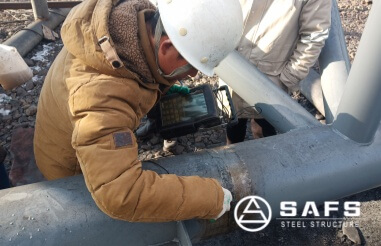Dapeng Town Industrial Park, Tongshan District, Xuzhou City, Jiangsu Province, China
In the modern construction field, steel structure is popular for its high strength, high efficiency and flexibility. However, the welding quality of steel structure is directly related to its overall performance and safety. Therefore, it is crucial to carry out non-destructive testing quality inspection of steel structure welds. This paper will introduce in detail how to carry out non-destructive testing quality inspection of steel structure welds to ensure the safety and stability of the building.

Nondestructive flaw detection of steel structure welds refers to the use of non-destructive methods to test the welded joints of steel structures to assess whether there are any defects or damages within them. Through non-destructive testing, defects such as cracks, porosity, slag entrapment and other defects in welded joints can be detected in time, so as to avoid construction safety accidents caused by quality problems of welded joints. At the same time, non-destructive testing can also provide scientific basis for the design, construction and maintenance of steel structure and improve the overall performance and service life of steel structure.
Ultrasonic Flaw Detection: Using the characteristic that ultrasonic wave will be reflected when it meets the interface when it propagates in the medium, it can judge whether there are defects inside the weld by observing the change of the reflected wave. Ultrasonic flaw detection has the advantages of high sensitivity, accurate positioning, etc., applicable to a variety of thickness of steel weld inspection.
Radiographic flaw detection: Using the characteristic of attenuation of rays when they penetrate the material, the image on the radiographic film is observed to judge whether there are defects inside the weld. Radiation flaw detection can clearly show the shape and location of the defects inside the weld, but requires specialized equipment and technical personnel to operate.
Magnetic Particle Flaw Detection: After magnetising the ferromagnetic material with magnetic field, magnetic powder is sprinkled on the surface to determine whether there are defects on the surface of the weld by observing the distribution of the magnetic powder. Magnetic particle flaw detection is suitable for ferromagnetic material weld inspection, has the advantages of simple operation, low cost and so on.
Penetration Flaw Detection: Using liquid penetrant to penetrate the surface of the weld, and then applying the developer to determine whether there are defects on the surface of the weld by observing the colour change of the developer. Penetration flaw detection is suitable for weld testing of various materials, but can only detect defects on the surface of the weld.
Preparation: Choose the appropriate flaw detection method and equipment according to the material, structural shape and size of the inspected work piece. At the same time, calibration and debugging of flaw detection equipment to ensure that it is in normal working condition.
Surface treatment: clean and polish the weld surface, remove oil, rust and other impurities, and ensure that the probe is in close contact with the weld surface. For the weld that needs to be detected by magnetic particle, it also needs to be magnetized.
Detection operation: operate according to the selected detection method, pay attention to control the moving speed and direction of the probe to ensure full coverage of the weld area. At the same time, record the data and abnormalities during the flaw detection process. 4.
Analysis of results: analyse and judge the results of the flaw detection to determine whether there are defects inside the weld and the type, size and location of the defects and other information. For the defects found should be timely treatment and repair.
Report preparation: the results of flaw detection is collated into a report form, including flaw detection methods, equipment parameters, flaw detection process, defects and other content. The report should be clear, accurate and reliable data to provide a basis for subsequent repair and maintenance.